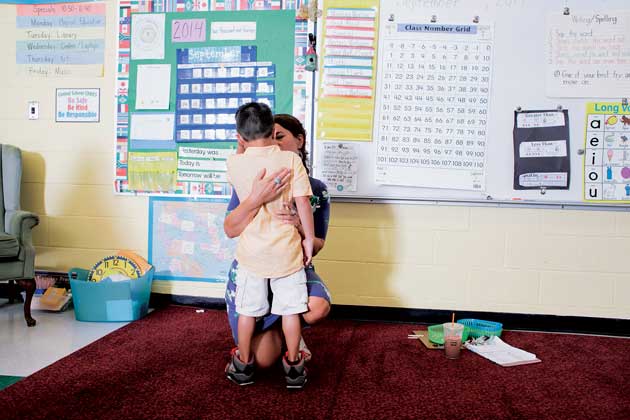Our number four pick comes from Mother Jones magazine. Most parents are familiar with the Ericsson model of punishment based on rewards and consequences. Time outs and positive reinforcement have long been the traditional model of molding our youth in schools and at homes. Recently there’s been more attention paid to those children who don’t respond well to this model. In the worst case scenarios children become habitualized to repeated punishments and researchers have tracked how a kindergartner with these tendencies escalates every year until their so unruly they’re sent to prison.
The expression “school-to-prison pipeline” was coined to describe how America’s public schools fail kids like Will. A first-grader whose unruly behavior goes uncorrected can become the fifth-grader with multiple suspensions, the eighth-grader who self-medicates, the high school dropout, and the 17-year-old convict. Yet even though today’s teachers are trained to be sensitive to “social-emotional development” and schools are committed to mainstreaming children with cognitive or developmental issues into regular classrooms, those advances in psychology often go out the window once a difficult kid starts acting out. Teachers and administrators still rely overwhelmingly on outdated systems of reward and punishment, using everything from red-yellow-green cards, behavior charts, and prizes to suspensions and expulsions.
How we deal with the most challenging kids remains rooted in B.F. Skinner’s mid-20th-century philosophy that human behavior is determined by consequences and bad behavior must be punished. (Pavlov figured it out first, with dogs.) During the 2011-12 school year, the US Department of Education counted 130,000 expulsions and roughly 7 million suspensions among 49 million K-12 students—one for every seven kids. The most recent estimates suggest there are also a quarter-million instances of corporal punishment in US schools every year.
Teachers who aim to control students’ behavior—rather than helping them control it themselves—undermine the very elements that are essential for motivation: autonomy, a sense of competence, and a capacity to relate to others.
Under Greene’s philosophy, you’d no more punish a child for yelling out in class or jumping out of his seat repeatedly than you would if he bombed a spelling test. You’d talk with the kid to figure out the reasons for the outburst (was he worried he would forget what he wanted to say?), then brainstorm alternative strategies for the next time he felt that way. The goal is to get to the root of the problem, not to discipline a kid for the way his brain is wired.
If Greene’s approach is correct, then the educators who continue to argue over the appropriate balance of incentives and consequences may be debating the wrong thing entirely. After all, what good does it do to punish a child who literally hasn’t yet acquired the brain functions required to control his behavior?
In a more typical school, a kid who seems to be threatening others might be physically restrained, segregated into a special-ed room, or sent home for the day. Children with learning and behavior disabilities are suspended at about twice the rate of their peers and incarcerated at nearly three times the rate of the overall youth population, government data shows. Will, like most of Central’s student body, is white, but for black kids with disabilities the suspension rate is 25 percent—more than 1 in 4 African American boys and 1 in 5 African American girls with disabilities will be suspended in a given school year.
Before Greene’s program was put in place, conventional discipline at Central was the norm. During the 2009-10 school year, kids were referred to the principal’s office for discipline 146 times, and two were suspended. Two years later, the number of referrals was down to 45, with zero suspensions, all thanks to focusing more on “meeting the child’s needs and solving problems instead of controlling behavior,” principal Nina D’Aran told me. “That’s a big shift.”
The CPS method hinges on training school (or prison or psych clinic) staff to nurture strong relationships—especially with the most disruptive kids—and to give kids a central role in solving their own problems. For instance, a teacher might see a challenging child dawdling on a worksheet and assume he’s being defiant, when in fact the kid is just hungry. A snack solves the problem. Before CPS, “we spent a lot of time trying to diagnose children by talking to each other,” D’Aran says. “Now we’re talking to the child and really believing the child when they say what the problems are.”
The impact of this new approach to handing difficult situations with children has far reaching well outside the bounds of the classroom.
Remarkably, the relationships changed. Kids began to see the staff as their allies, and the staff no longer felt like their adversaries. The violent outbursts waned. There were fewer disciplinary write-ups and fewer injuries to kids or staff. And once they got out, the kids were far better at not getting locked up again: Long Creek’s one-year recidivism rate plummeted from 75 percent in 1999 to 33 percent in 2012. “The senior staff that resisted us the most,” Bouffard told me, “would come back to me and say, ‘I wish we had done this sooner. I don’t have the bruises, my muscles aren’t strained from wrestling, and I really feel I accomplished something.'”






